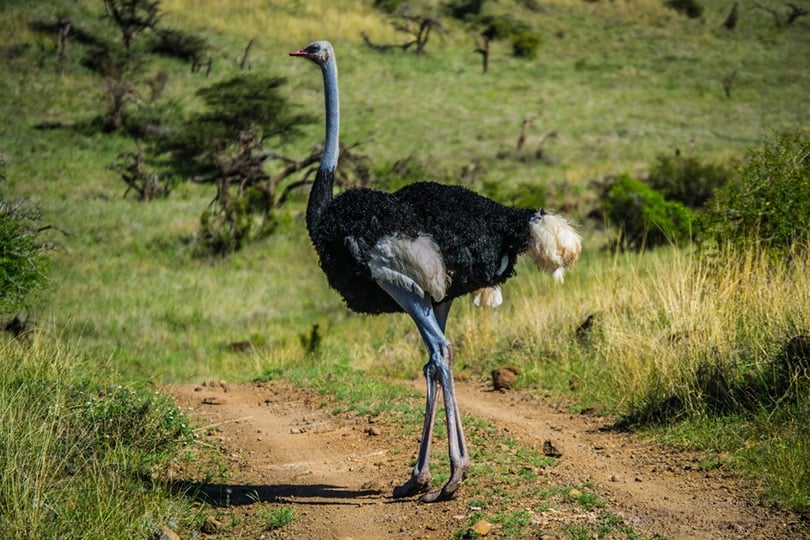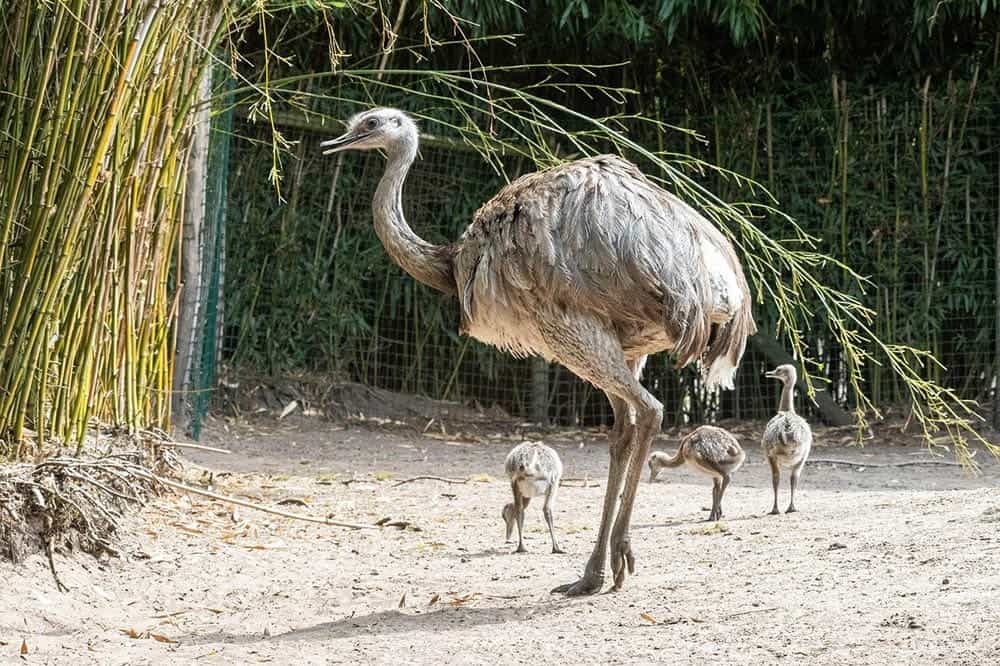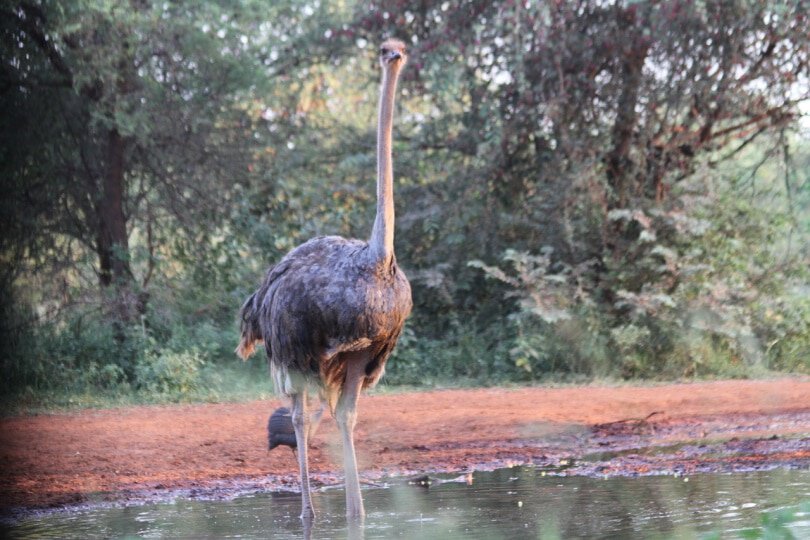Although they’re flightless, ostriches have several skills that most birds lack. They can reach 43 miles per hour in short bursts, and they’re capable of sustaining 33 miles per hour when fleeing from predators. They’re one of the few creatures that can incapacitate a lion with a single kick, and unlike most birds, they lay eggs in communal nests. Ostriches like to cool off in the water, but can the birds swim? Yes, ostriches can swim, although it’s not a regular part of their daily routines.
Ostriches are not fast swimmers, but they use their strong legs in a walking motion to propel themselves through the water. Since their feathers are not waterproof like most birds, ostriches typically seek shelter from the rain and limit their time wading in the water. Damp feathers can lower their body temperature, and most ostriches will not spend all day in a pond like a waterfowl.

Remarkable Characteristics of Ostriches
Ostriches are best known for their running speed and massive bodies, but the birds are more complex than most people think. Although the ratites do not mate for life, they are social creatures that fiercely protect their offspring and live in large groups for most of the year.

Social Nature
During the dry season, ostriches join flocks of five to 50 birds. In some African countries, the ostriches face several threats from predators like lions, leopards, cheetahs, and hunting dogs. However, the greatest threats to their population numbers are raptors, humans, and smaller mammals that steal ostrich eggs. In larger groups, the birds are more protected from danger, and they also help other species by warning them of approaching predators.
Ostriches have unique vocalizations that include hisses, whistles, and snorts, but the male shows off his most thunderous call when a predator approaches. Some researchers have compared the ostrich call to a lion’s roar, and the sound signals other wildlife to leave the area. Ostriches have, and when the large animals graze, they stir up insects and rodents for the birds to eat. The large birds return the favor by roaring when a large cat approaches.

Mating
Male ostriches have brilliant black feathers with white tips, and the hens’ colors are duller brown. Roosters use their bushy feathers to attract mates, but they do not limit their mating rituals to one female. Ostriches are polygamists, and they typically choose a “major hen” as a primary mate and two or more “minor hens.” Some males can have up to ten minor hens, and nests contain over 60 eggs.
Unlike most species, ostriches keep their eggs in communal nests. The major hen takes turns with the father incubating the eggs, but the minor hens are not involved in the child-rearing process. Minor hens sometimes join flocks with non-mating males, but only around 33% of females become major hens.
Protecting the Young
Ostrich eggs weigh over 3 pounds, and they’re usually 6 inches long. The only creatures that had larger eggs were the dinosaurs, and they’re probably the only ones that had bigger babies. Ostrich hatchlings are as large as full-grown chickens, and they mature quickly in communal nurseries.
If a lion or other large mammal approaches the community, the male will run off and lead the predator away from the young. The hen will take the juveniles, including offspring from other mothers to another area until it’s safe to return. Ostriches can also hide from the invaders temporarily by lying down flat against the ground. The ostrich is the only ratite that protects the young with both sexes, and most like the rhea and emu only rely on roosters to protect the flock.

Staying Cool
The savannahs and semi-arid regions of Africa are harsh environments with few water sources and limited rainfall. However, ostriches have adapted well to the oppressive climate, and they do not need water sources to stay hydrated. Their bodies receive moisture from the insects, plants, and reptiles they eat, but they drink from streams when they have the opportunity. Ostriches use selective brain cooling to stay cool by uncoupling the brain’s temperature from the temperature of arterial blood.
Gizzard Assistance
Ostriches do not have teeth, but they help their gizzards digest meals by swallowing small rocks and gravel. All birds have gizzards, but those that depend on soft-bellied insects and nectar do not have to swallow stones to aid digestion.
Defensive Weapons
Ostrich feathers are useless for flying away from predators, but they’re essential to the males’ role in mating rituals. Although they’re flightless, ostriches are far from defenseless. At over 9 feet tall and weighing over 220 pounds, the bird is an imposing figure to smaller mammals, and only the most skilled and powerful felines attack ostriches.
Ostriches are safer in large flocks, but their razor-sharp talons are their last line of defense against attacks. Since ostriches can run over 33 miles per hour, their powerful legs can break backbones, and their talons can tear into flesh.

Longevity
Ostriches are hardy birds that enjoy long lifespans when they successfully evade predators. In the wild, ostriches can live 40 to 50 years, but they can live longer in captivity when fed healthy diets. Although the common ostrich is considered an animal of the least concern, its population continues to dwindle due to urbanization, hunting, and egg theft.
Humans, raptors, and small animals often raid nests for eggs, and some ornithologists speculate that the declining numbers are related to the small percentage of offspring that survive. During a study conducted in 1986, an ornithologist discovered that 152 ostrich eggs laid in one year in Kenya only resulted in 16 offspring due to heavy predation of the eggs.
 Ostriches as Pets and Entertainers
Ostriches as Pets and Entertainers
Although they live long lives and produce nutritious, dinosaur-sized eggs, ostriches are not ideal pets. Males and females get more aggressive during the breeding season, and only highly trained handlers can care for the birds. A kick from an ostrich can disembowel a human, and you have several less hazardous options for pets or animals on small farms.
The safest way to interact with the birds is to visit an ostrich farm. The ostriches are tamer than wild birds, and they’re supervised by wildlife experts. Some farms allow rides on the ostriches, but animal rights organizations like PETA, suggest avoiding the temptation to ride the birds. Unlike horses, ostrich bodies are not suitable for human riders.
Ostrich races are a popular attraction in southern Africa and some parts of the United States, but some travel companies, like Tribes Travel, have stopped offering ostrich rides to customers after PETA supporters convinced them the practice is inhumane. The rides can injure ostriches, but humans also face risks. Ostriches do not run in linear paths like horses; their movements are more erratic and harder to control.


Final Thoughts
Ostriches are the world’s largest ratites, and although they’re incapable of flight, they have other traits that most avian species lack. They can swim in rivers, lakes, and oceans when they need to cool off, and they’re the only bird that can run faster than a Ford Model T to escape predators. Their powerful kicks can break a lion’s backbone, and their vocalizations protect other grazing creatures from approaching threats. The ostrich is not endangered, but the wild flocks are dwindling, and it’s vital to continue supporting ostrich farms to sustain and hopefully increase the bird’s population.
Featured Image Credit: mbredl, Pixabay
